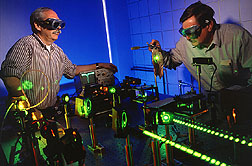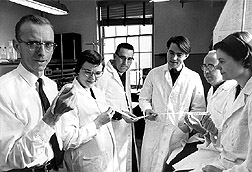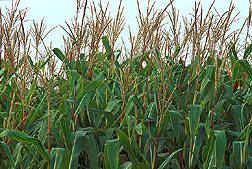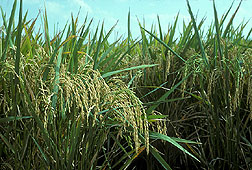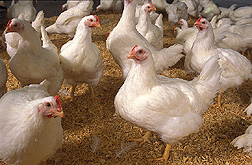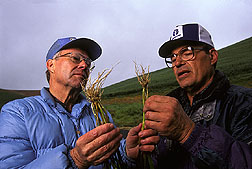Powerful Partnerships Fuel Research Advances
A splash of light illuminates fecal contamination too small to be detected by eye on a beef carcass as it moves down the production line, immediately alerting the meat packer to a potential problem. The packer won’t have to trim away meat because it might be contaminated; he’ll know when to take action. The result is reduced risk of foodborne illness for consumers and lower production costs.
That light was emitted by a device invented by microbiologists Mark A. Rasmussen and Tom Casey with ARS’s National Animal Disease Center (NADC) in Ames, Iowa, and Jacob W. Petrich, with the Department of Chemistry at Iowa State University. The scanner, which is based on use of fluorescent spectroscopy, takes the subjectivity out of meat inspection and is not subject to fatigue and human error.
It is also a classic example of the successes that have come from collaborations between the Agricultural Research Service and land-grant colleges and universities.
“This project would not have happened if we had not been working together,” Rasmussen says. “We leveraged our knowledge of animal disease and food safety with Iowa State University’s expertise in light and physics. Jacob Petrich gave the team someone who understood how light interacts with matter, and then we all connected it to solving the problem.”
Petrich adds, “Tom, Mark, and I each brought different ideas to the table. We started off with some casual conversations about whether light-based technology could be useful in food safety and ended up running samples between our labs almost daily.” The labs are less than 10 minutes apart.
It is not by chance that NADC is located so close to Iowa State University (ISU). When the center was created in 1956, the Ames location was selected mainly because ISU provided opportunities for cooperation between professional personnel of the laboratory and the university as well as scientists in areas such as physics, nuclear research, mathematics, and statistics, according to the Investigative Site Committee’s report.
“This is what can come when you give researchers in such different fields easy access to each other,” Rasmussen says.
Today, eMerge Interactive, Inc., of Sebastian, Florida, has licensed the scanning device and is marketing it.
Now, the ARS-ISU team is expanding its fluorescent spectroscopy technology in hopes that it could be used to diagnose transmissible spongiform encephalopathies, including mad cow disease, in live animals.
“Fundamentally, these types of partnerships are a perfect mesh of interests and collaboration for the public good,” says C. Peter Magrath, president of the National Association of State Universities and Land-Grant Colleges.
Land-grant universities and colleges were established by Congress with the Justin Smith Morrill Act in 1862, the same year that the Department of Agriculture was created. And while ARS itself was not formally organized under its current name until 1953, many of its laboratories and research programs were created by USDA in the 1880s.
ARS and the land-grant schools are complementary research systems.
ARS, as the in-house research arm of USDA, usually has a broad focus or national scope, tackling research with diverse approaches and contexts. The agency is funded by congressional appropriations that can support multi-year, long-term projects not suited to annual or short-term grants.
Land-grant schools focus more on solving important local and regional problems. These colleges and universities have a breadth of of expertise far beyond agricultural sciences that provides a great pool of resources.
“ARS considers our university friends to be our strongest partners, cooperators, and even stakeholders. We can certainly accomplish more together than either of us alone,” says ARS Administrator Edward B. B. Knipling. “We encourage all our scientists to look at the potential for such collaborations and how we can all benefit from shared abilities and facilities. The cooperation has been incredibly successful over the years.”
Partnering with ARS from within USDA is the Cooperative State Research, Education, and Extension Service (CSREES), which provides grants that support many collaborations between land-grant schools and ARS.
“We’ve focused a lot of our attention on co-funding and co-sponsoring work of collaborators from universities and ARS through our competitive grants programs and other mechanisms,” says CSREES Administrator Colien Hefferan.
|
|
Collaborative Landmarks
The list of accomplishments that have come from partnerships between ARS and land-grant schools is virtually endless. One even resulted in the ultimate scientific kudo.
Five ARS and three Cornell University scientists teamed up to become the first to determine the molecular structure of RNA in 1965. This achievement won the team’s leader, biochemist Robert W. Holley, who worked for both ARS and Cornell, a share of the 1968 Nobel Prize for medicine or physiology.
Not quite as highly recognized are the widespread and essential partnerships that have given rise to critical new crop varieties.
For example, the soybean variety Williams 82 was created through collaboration between ARS and the Illinois Agricultural Experiment Station at the University of Illinois in 1988. Williams 82 is considered by many to be one of the most important soybean varieties ever bred; it was the first with resistance to 19 of the 24 races of Phytophthora root rot.
Corn variety B76, which came out of a joint ARS-Iowa State University program in the 1970s and 1980s, remains the basis for nearly every seed-parent line of corn in the U.S. Corn Belt and much of the rest of the world. A 1990 study found that the lines from this partnership have been so widely used that they should be accorded a major share of credit for the more than doubling of corn yield during the past 40 years. This yield increase has produced an estimated $1 billion per year for American farmers.
The elite rice variety Lemont, considered a landmark variety in the United States, was released in 1983 by ARS and the Texas Experiment Station (Texas A&M University). Lemont was one of the first, and later one of the most widely used, high-yielding semidwarf rices. At the peak of its popularity, Lemont was grown on 80 percent of U.S. rice land—more than 1 million acres in Texas, Louisiana, and Mississippi.
|
|
Centers of Excellence
Hand in hand with the original land-grant system was the creation of the historically black land-grant colleges and universities, authorized in 1890, mainly to assist minority farmers, especially in the South.
ARS’s partnerships with the 1890 schools not only include direct research collaboration, but also help to introduce or strengthen agricultural academic programs.
ARS food technologist Thomas P. Oscar’s research is about developing better tools to predict growth and survival of Salmonella and Campylobacter—the two most prevalent bacterial food pathogens—in poultry. About 10 percent of the estimated 1.4 million cases of Salmonella-caused food poisoning that occur each year in the United States come from poultry.
Oscar’s lab is located at the University of Maryland-Eastern Shore (UMES) in Princess Anne, Maryland, and he works closely with UMES scientists. For example, one of Oscar’s recent findings—that Salmonella populations grow much more slowly than previously believed in the presence of other populations of bacteria—was significantly helped along by the work of UMES assistant professor Dwayne Boucaud and graduate student Kalpana Dulal. They developed methods to make Salmonella more easily identifiable among living populations of mixed bacteria on poultry.
But the cooperation goes much deeper than that. In 1995, ARS created a Center of Excellence at UMES to help create a food science program at the school.
“When ARS arrived on campus 10 years ago, nobody at UMES was doing food science or food safety research,” Oscar recounts. “Since then, we’ve had successful collaborations with several UMES faculty members, and we’ve meant a lot to the UMES undergraduate and graduate students who have worked in our lab.”
ARS also helped UMES secure $17 million to build a state-of-the-art food science and technology laboratory facility, and the school now has its first agricultural Ph.D. program.
“The building and Ph.D. program have both been strengthened by our partnership. And with a Ph.D. program at a historically black university like UMES, ARS will have a bigger pool of qualified scientists to help us diversify our agency and department,” Oscar says.
Both Sides of the Lab Bench
Plant pathologist R. James Cook has been on both sides of the lab bench when it comes to collaborations between ARS and colleges and universities. He was with an ARS lab at Washington State University (WSU) from 1965 to 1998, developing the agency’s program on root disease of wheat and barley. He then became a faculty member at WSU and, in 2003, became interim dean of Agricultural, Human, and Natural Resources Sciences at the school.
“I essentially just had to move from one office to another on the same floor in the same building,” he says. “There is this seamless connection that benefits both sides so much.”
Cook points out how expensive research has gotten and that collaborations can make the best use of resources, including costly equipment and land for field experiments. “Collaboration can mean sharing new equipment instead of everybody buying their own gene sequencer or field plot combine, equipment you might not need every day.
“There is also the synergy and intellectual stimulation that comes when you interact with university professors, students, and visiting scientists, along with the sheer hours contributed by graduate students,” he adds. “While I was with ARS, collaborations with the university probably contributed 30 scientist years all fully integrated into my research program, doing projects that might take 6 months or a year of effort but that I didn’t have time to do. At least three major changes in the direction of my program were made possible by breakthroughs done in graduate-student thesis research.
“Clearly, if what I’ve seen in 40 years of research—the increase in complexity and challenges in solving problems—continues as a trend, we’ll need to work together in the future more than ever. I think it’s one of the greatest partnerships in existence.”—By J. Kim Kaplan, Agricultural Research Service Information Staff.
To reach scientists in this story, contact Kim Kaplan, USDA-ARS Information Staff, 5601 Sunnyside Ave., Room 1-2253, Beltsville, MD 20705-5128; phone (301) 504-1637, fax (301) 504-1648.
A Share of the Collaborations
ARS scientists gained access to almost $110 million in additional resources in 2004 as a result of formal partnerships with universities and colleges, nonprofit institutions, and other federal agencies.
Many other collaborations each year are more informal—not requiring the weight of a legal extramural agreement—while certainly offering rich benefits to both ARS researchers and their outside partners.
“The dividing line for when a collaboration needs to be formalized is when a researcher starts committing substantial resources to it—and that includes their time and facilities as well as actual dollars,” says ARS Extramural Agreements Division director Curtis Wilburn.
Key to the success of such formal partnerships is making sure that everyone understands the objectives, expectations, and responsibilities.
“Everybody needs to be clear about what they’ve agreed to in terms of resource contributions and project performance. Then the researchers need to be accountable for carrying that out,” Wilburn explains.
But setting up a formal partnership need not be onerous or complex. “We have people that can help make it easy, from the location administrative officers to the Extramural Agreements Division here at headquarters,” Wilburn says.
Of course, the impetus for a partnership can come from outside ARS as easily as from inside, Wilburn adds. It just needs to be about research of mutual interest with resource contributions from both parties.
For more information about extramural agreements, see www.afm.ars.usda.gov/ead or call (301) 504-1147.
"Powerful Partnerships Fuel Research Advances" was published in the July 2005 issue of Agricultural Research magazine.







